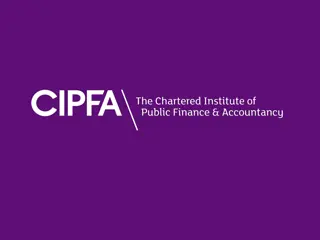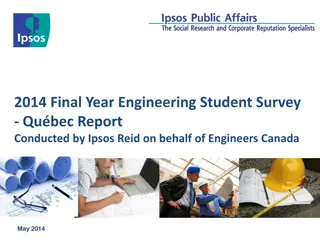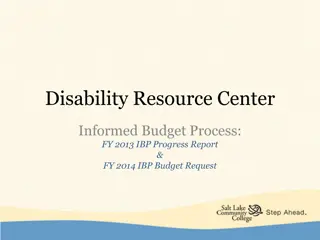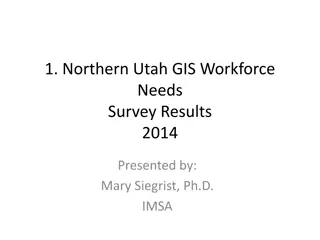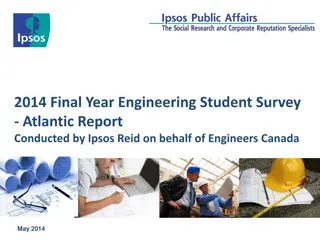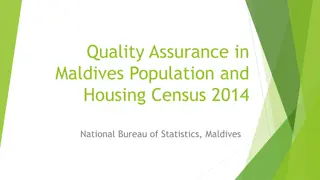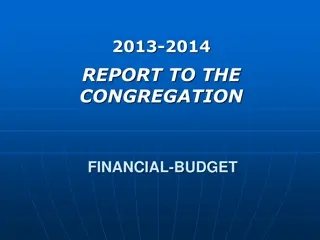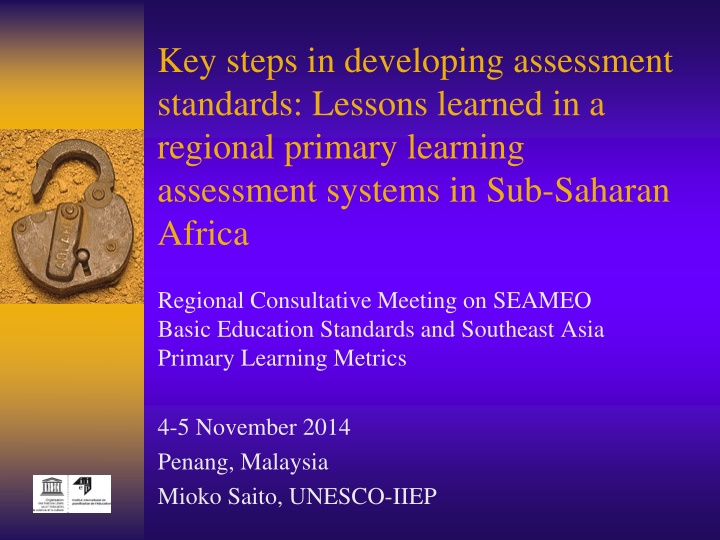
Key Steps in Developing Assessment Standards: Lessons from Sub-Saharan Africa
Explore the key steps in developing assessment standards based on lessons learned from a regional primary learning assessment systems meeting in Sub-Saharan Africa. Understand the involvement of International Institute for Educational Planning (IIEP) and the importance of assessment in the policy cycle. Discover IIEP's approach to achieving international goals in learning assessments through long-term capacity building.
Download Presentation

Please find below an Image/Link to download the presentation.
The content on the website is provided AS IS for your information and personal use only. It may not be sold, licensed, or shared on other websites without obtaining consent from the author. If you encounter any issues during the download, it is possible that the publisher has removed the file from their server.
You are allowed to download the files provided on this website for personal or commercial use, subject to the condition that they are used lawfully. All files are the property of their respective owners.
The content on the website is provided AS IS for your information and personal use only. It may not be sold, licensed, or shared on other websites without obtaining consent from the author.
E N D
Presentation Transcript
Key steps in developing assessment standards: Lessons learned in a regional primary learning assessment systems in Sub-Saharan Africa Regional Consultative Meeting on SEAMEO Basic Education Standards and Southeast Asia Primary Learning Metrics 4-5 November 2014 Penang, Malaysia Mioko Saito, UNESCO-IIEP
Presentation structure IIEP s involvement in large-scale assessments Assessment as an integral part of policy cycle Key steps in developing assessment standards 4
International Institute for Educational Planning (IIEP) and Large-scale Assessments 1995-1998 SACMEQ I IIEP as a Coordinator 1999-2004 SACMEQ II IIEP as a Partner 2005-present SACMEQ III & IV IIEP as a Supporter 1989-1994 Large-scale National Assessment in Zimbabwe IIEP as an Initiator Large-scale Regional Assessment SACMEQ as an independent organization 2000-2003 Large-scale National Assessment in Viet Nam IIEP as a Partner Large-scale Regional Assessments? WEF 1990 Jomtien WEF 2000 Dakar WEF 2015 Incheon
IIEPs approach to achieve international goals on learning assessments NOT a short-term crisis management by external agencies Long-term capacity building to: Provide advanced technical training required to undertake high-quality, large-scale, scientific studies Foster an information culture where policy decisions are informed decisions.
Policy Cycle Policy Cycle Policy Evaluation Phase Programme implementation General policy concerns Policy Research Phase Policy reform and agenda for action Policy Development Phase Source: Saito (1999) Consultation and debate Specific research questions Data Policy suggestions collection and analysis Interpretation and reporting
SACMEQ Working Style Ownership = Ministries of Education Not a research project -- but educational planners involved in research Target population & test framework based on policy and planning context Highest priority: "learning by doing" approach Institutional capacity building Regional collaboration Self-help approach South-south cooperation Source: Saito & van Cappelle (2010)
Analyze official curricula, school syllabi, textbooks, and examinations Describe domains (content) Describe skills (behaviours) Construct test blueprint (domains by skills grid) Test Construction Steps Write trial-test items (twice as many as required) Implement trial testing and complete Rasch and classical item analysis Select test items to achieve (a) balance across test blueprint, and (b) overlaps with other studies Cross-check the descriptions of competency levels with the test blueprint to ensure face validity and construct validity Implement main data collection Conduct Rasch item calibration and test equating Complete skills audit to identify the specific skills required for success on each item Cluster items with similar difficulties and requiring similar skills into competency levels Develop summary descriptions for each competency level Source: Ross et al (2004)
SACMEQ Comparison Comparisons across sub-groups (sex, location, SES) Comparisons against Ministry s benchmark standards (defined by subject experts) Comparisons across levels of competence Comparison between time Comparison between pupils and teachers Comparison among countries Comparison with other international studies (IEA- PIRLS, TIMSS, PASEC) Sources: Ross et al (2004); Saito & van Cappelle (2010)
References Ross, K., Saito, M., Dolata, S., Ikeda, M., & Zuze, L. 2004. Data archive for the SACMEQ I and SACMEQ II projects. Paris: IIEP- UNESCO. Saito, M. (1999). A generalizable model for educational policy research in developing countries. Journal of International Cooperation in Education, 2(2), pp. 107-118. Saito, M. & van Cappelle, F. (2010). Monitoring the quality of Education: Exploration of concept, methodology, and the link between research and policy . In: A.W. Wiseman (Ed.) 2010. The impact of international achievement studies on national education policymaking. International perspectives on education and society, Vol. 13 (pp. 3-34). Bingley: Emerald Group Publishing. 11
For more information about SACMEQ: www.sacmeq.org To apply for the IIEP s Advanced Training Programme for Educational Planning and Management: tep@iiep.unesco.org To apply for the IIEP s Specialized Course on Quantitative Methods for Monitoring and Evaluating the Quality of Education: m.saito@iiep.unesco.org 12






